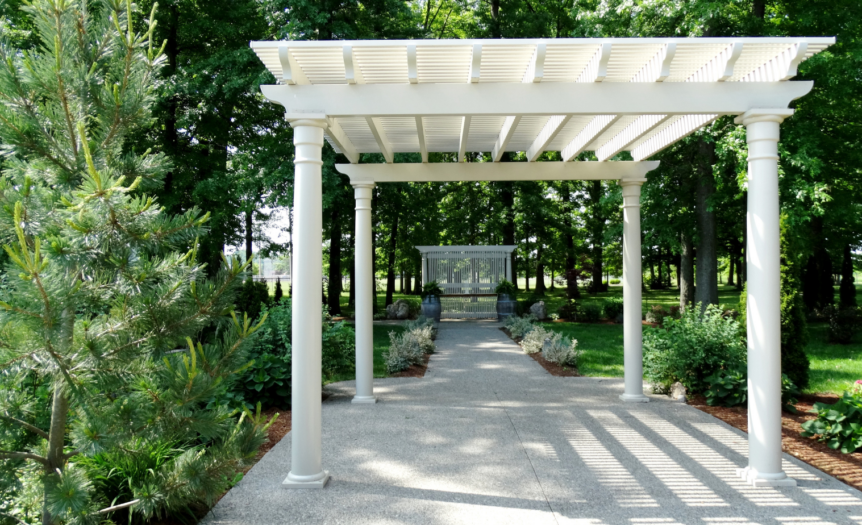Screening in a gazebo can be an excellent way to enhance your backyard living space while providing privacy, shade, and protection from pesky insects.
If you’re considering this project but not sure where to begin, look no further!
This comprehensive guide will walk you through the process of screening in a gazebo and share tips on choosing materials, framing techniques, installation steps, and various enhancements to create an inviting outdoor oasis.
With some DIY skills and dedication, you’ll soon have a beautifully screened gazebo perfect for relaxation or entertaining guests.
Benefits Of Screening In A Gazebo
Screening in a gazebo provides numerous benefits, such as protection from insects and pests, privacy and shade, improved airflow and ventilation, and aesthetic appeal.
Protection From Insects And Pests
Screening in your gazebo offers a valuable layer of protection against pesky insects and pests, ensuring that you can enjoy outdoor relaxation without annoying interruptions.
A prime example of this benefit involves the use of fiberglass mesh screens, which are known for their durability and effectiveness in keeping insects at bay. This material not only provides excellent shielding from bugs but also resists damage and wear over time – allowing you to maintain an insect-free environment for years to come.
Privacy And Shade
A screened-in gazebo offers both privacy and shade, making it the perfect location for intimate gatherings or outdoor relaxation. The screens keep prying eyes out while allowing you to enjoy the scenery around you without distractions.
Additionally, the screens provide a soothing shade from the sun’s harsh rays, ensuring that your comfort isn’t compromised when sitting outside during peak hours of sunshine.
Adding curtains or shades can further enhance your privacy levels while also adding flair to your gazebo’s design. You can choose different colors and patterns that match perfectly with your surrounding decor to create an elegant feel in any space.
Improved Airflow And Ventilation
Screening in your gazebo not only provides protection from the elements and insects, but it also improves airflow and ventilation. Having screens on each side of the structure allows for a natural cross-breeze to flow through, making it a perfect spot to relax in hot summer days.
Additionally, screened gazebos provide an ideal space for outdoor cooking or dining since they allow smoke and cooking fumes to escape easily. Adding ceiling fans or installing mesh curtains with zippers can help control airflow while keeping unwanted bugs at bay.
Aesthetic Appeal
Screening in your gazebo not only provides practical benefits, but it also adds to the overall aesthetic appeal of your backyard.
The addition of curtains or shades can provide both privacy and design elements for your outdoor oasis. You can choose from various colors and patterns depending on the look you are trying to achieve.
Additionally, adding lighting fixtures and ceiling fans creates an inviting ambiance that is perfect for evening events or summer nights with family and friends.
Steps To Screen In A Gazebo
To screen in a gazebo, begin by choosing the right screening material and measuring it to size, then frame the screens and install them onto the gazebo before securely locking them in place; learn more about these steps and enhance your screened gazebo’s functionality with our expert tips.
Choose The Right Screening Material
The first step in screening a gazebo is to choose the right material. Fiberglass mesh is an ideal choice for those looking for a durable and long-lasting option that can withstand tough weather conditions.
If you’re after something more aesthetically pleasing, vinyl-coated polyester may be the way to go.
Another essential factor when considering screening materials is air flow. A fine-meshed screen will provide adequate ventilation while keeping out pesky insects and pests at bay.
Measure And Cut The Screen To Size
Before you start attaching the screens to your gazebo frame, it’s important to measure and cut them down to size. Lay out your screening material on a flat surface and double-check that it’s large enough to cover the entire opening of your gazebo.
Next comes cutting. Use scissors or a utility knife (depending on what type of screen material you’re using) and carefully trim along the marked lines.
Keep in mind that fiberglass mesh is the most durable option for screening material and will hold up better against wear and tear over time.
Frame The Screens
After cutting and measuring the screens to size, the next step is framing them for installation on the gazebo. The frames can be made with wooden strips or aluminum channels depending on your preference.
If you’re using wood, ensure that it’s been treated with a weather-resistant staining product before attaching it to your gazebo.
For easy installation, attach small hinges onto one of the sides of each screen frame so that you can open and close them easily when needed. Once all frames have been hinged, it’s time to install them onto the Gazebo.
Install The Framed Screens Onto The Gazebo
Once you have your screens framed, it’s time to install them onto the gazebo. This step includes attaching the screen frames to the wooden frame of your gazebo using screws.
Start by laying out all of your materials and tools for easy access.
Begin by fitting each one of your framed screens into position, ensuring they are aligned correctly before securing them with screws that won’t rust or corrode over time.
If needed, add additional screws along the edges for extra support.
Once all screens are attached and secured properly, take a step back and admire your newly screened gazebo!
With its increased privacy from curious eyes outside, protection from insects & unwanted critters (including mosquitoes), improved ventilation system thanks to more breeze flowing through open sides – there’s nothing quite like relaxing in this outdoor haven on hot summer days without worrying about bugs buzzing around biting you!
Secure The Screens In Place
After framing and attaching the screens to your gazebo, securing them in place is the next crucial step. First, ensure that there are no wrinkles or gaps in the screening material as this may allow bugs and insects to enter into your screened-in area.
Next, use screws or other hardware recommended by the manufacturer to secure each corner of the screen panel onto the frame.
For added security, consider installing a locking system on any doors or windows you have included in your screened-in gazebo design.
Remember that proper maintenance is key for ensuring long-term protection from pests and privacy in your screened-in gazebo.
Enhancing Your Screened Gazebo
To take your screened gazebo to the next level, consider adding a screened door for convenience, installing lighting fixtures and fans for ambiance and comfort, or even adding curtains or shades for added privacy and design.
Adding A Screened Door
To further enhance the functionality of a screened gazebo, adding a screened door can provide easy access while keeping pesky insects out. A variety of screen doors are available, including sliding and swinging options.
For those who prefer an unobstructed view or more breeze flow, retractable screen doors could be the perfect solution.
Moreover, having a screened door also adds to the aesthetic appeal of the gazebo while increasing privacy and security. With many options available on the market today, adding a screened door to your gazebo can make it an even more comfortable outdoor living space for years to come.
Adding A Roof For Protection
Adding a roof to your screened gazebo provides extra protection from the elements, allowing you to enjoy your outdoor space in any weather. A roof also helps prevent debris, leaves, and rain from getting inside the gazebo.
There are various options available for roofing, including wood shingles or metal panels. If you opt for wood shingles, be sure to apply a protective stain regularly to maintain their durability over time.
A well-designed screened gazebo with a sturdy roof is perfect for hosting outdoor gatherings free of outside interference. It offers an open-air feel while still providing adequate shelter against harsh sun rays or wetness from rainfall.
Adding Lighting Fixtures And Fans
Enhancing your screened gazebo with lighting fixtures and fans can take your outdoor space to the next level. Adding soft ambient lighting or overhead lights that mimic stars will create a cozy atmosphere for nighttime gatherings.
When choosing lighting fixtures and fans, consider the theme of your outdoor décor.
To avoid electrical mishaps, hire a licensed electrician to install outlets and wiring in your gazebo before adding any fixtures.
Remember that adding lighting and fans are just some of many ways to make your screened gazebo more comfortable and enjoyable.
Adding Power Outlets
Adding power outlets to your screened gazebo can greatly enhance its functionality and convenience. You can easily install electric sockets that cater to your entertainment needs, such as powering a sound system or watching TV.
Power outlets also provide added safety when cooking with electrical appliances. Installing them near cooking areas allows for easy use of an electric grill or hot plate without needing extension cords or running wires from inside the house.
Overall, adding power outlets to your screened gazebo is a smart way to make it more functional and comfortable year-round.
Adding Curtains Or Shades For Privacy And Design
Incorporating curtains or shades into your screened gazebo is an excellent way to add privacy and design. It can create a cozy and intimate atmosphere perfect for reading, relaxing, or entertaining guests.
Privacy curtains also offer protection from the wind and outdoor elements while adding another layer of security.
One popular choice is using outdoor drapes made from durable fabrics like Sunbrella®, which are resistant to sun fading and water damage. Other options include bamboo roller blinds or sheer voile fabric for a more romantic look.
Maintenance Tips For Your Screened Gazebo
Regular inspection and cleaning are key to proper maintenance of your screened gazebo. Don’t forget to repair any tears or holes, trim surrounding foliage, and consider applying a protective stain.
Regular Inspection And Cleaning
To keep your screened gazebo in tip-top shape, it’s important to do regular inspections and cleanings. This will help prevent any damage or repairs that may need to be done down the line.
One thing you should check is for any tears or holes in the screening material. If you find any, patch them up as soon as possible using a repair kit or replacement screen material.
Another important area to check is around the frames and joints of the screens themselves.
When it comes to cleaning your screened gazebo, there are a few things to keep in mind depending on what type of material you have. For vinyl screens, mild soap and warm water should do the trick – just make sure not to use anything abrasive that could scratch the surface.
Fiberglass screens can also be cleaned with soap and water, but avoid using bleach since this could damage the fibers over time.
Repairing Tears Or Holes
Even with proper maintenance, tears or holes in your gazebo screens are bound to happen. Luckily, repairing them is a straightforward process. The first step is identifying the tear or hole and measuring its size.
Use a needle and thread to sew around the edges of the patch onto the screen frame. For larger tears or holes, you can use screen repair tape on either side of the screen for extra reinforcement before sewing on the patch.
Trimming Surrounding Foliage
Regularly trimming surrounding foliage is essential to maintaining a screened gazebo. Over time, tree branches and overgrown bushes can scratch or tear the screens, compromising their ability to keep bugs out.
It’s also important to keep foliage away from the structure itself as fallen leaves and debris can accumulate in nooks and crannies, leading to mold or mildew growth that can damage both the frame and screens.
Additionally, keeping vegetation at bay ensures that your screened gazebo stays well-lit with natural light throughout the day.
Conclusion
Screening in your gazebo is an affordable and easy way to add valuable living space to your backyard. Whether you’re looking for privacy, protection from insects or shade, a screened gazebo provides all of these benefits and more.
Following the simple steps outlined above, anyone can screen in a gazebo with little effort or expense. From choosing the right screening material to enhancing with additional features like lighting and curtains for privacy, there are endless options to customize your screened-in oasis.
Related Posts
How to keep birds out of my gazebo
Can you put solar panels on a gazebo
What’s the difference between a gazebo and a pavilion
Where to put a gazebo in the backyard
How to keep a gazebo from blowing away
How to hang lights in a gazebo
How to hang gazebo curtains
How to level a gazebo on sloped concrete
What to do with an old metal gazebo frame
How to move a gazebo
Do you need a permit for a gazebo
How to build a gazebo on a deck
How to anchor a gazebo without drilling
How to decorate a gazebo for a wedding
How much does a gazebo cost
How to build a gazebo roof
What is a gazebo used for
What is the difference between a gazebo and pergola







